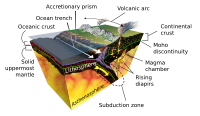
Photo from wikipedia
The thermal regime of continental lithosphere plays a fundamental role in controlling the behavior of tectonic plates. In this work, we assess the thermal state of the North American upper… Click to show full abstract
The thermal regime of continental lithosphere plays a fundamental role in controlling the behavior of tectonic plates. In this work, we assess the thermal state of the North American upper mantle by combining shear‐wave velocity models, calculated using data from the EarthScope facility, with empirically derived anelasticity models and basalt thermobarometry. We estimate the depth of the thermal lithosphere‐asthenosphere boundary (LAB), defined as the intersection of a geotherm with the 1300°C adiabat. Results show lithospheric thicknesses across the contiguous US vary between ∼40 km and >200 km. The thinnest thermal lithosphere is observed in the tectonically active western US and the thickest lithosphere in the midcontinent. By combining geotherm estimates with solidus curves for peridotite, we show that a pervasive partial melt zone is common within the western US upper mantle and that partial melt is absent in the eastern and central US without significant metasomatism.
Journal Title: Geophysical Research Letters
Year Published: 2021
Link to full text (if available)
Share on Social Media: Sign Up to like & get
recommendations!